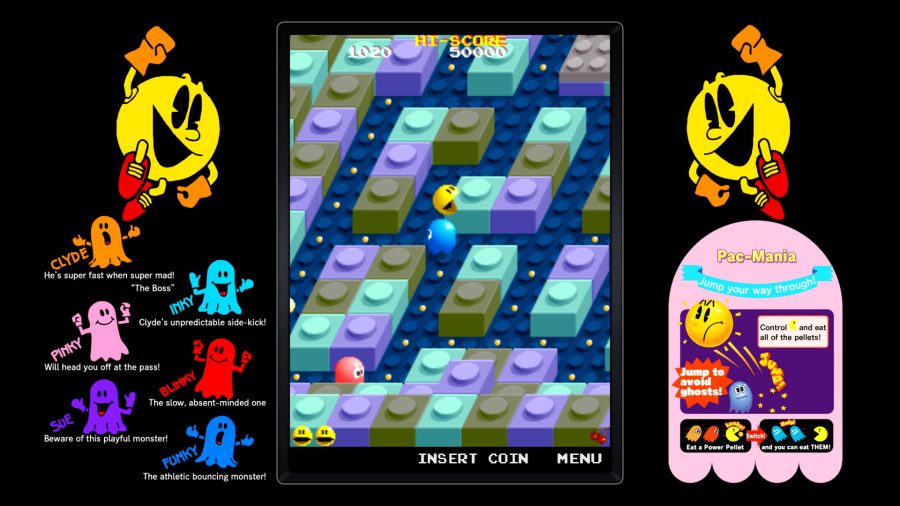Classic arcade games marked a turning point in the video game industry. From their start in the late 1970s to their peak in the 1980s, they laid the groundwork for modern gaming. Simple design, catchy soundtracks, and fast-paced gameplay captivated players and left a lasting impact on game design and culture.
Their influence comes from the ability to engage players quickly. Games like Pac-Man, Donkey Kong, and Space Invaders didn’t rely on complex stories or advanced graphics but instead used basic mechanics that anyone could grasp while offering a challenge that kept players coming back. As mentioned by mass.gov, arcade games have been instrumental in providing entertainment, including various popular games like skeeball, basketball shot, and coin-operated games of skill and chance. These elements, shaped by technological limits, became timeless and still resonate in today’s gaming world.
The Visual Appeal of Classic Arcade Games
Classic arcade games stood out for their bold, vibrant visuals. Designed to capture attention in busy arcades, these games used simple yet striking graphics. Bright neon mazes in Pac-Man and pixelated spaceships in Galaga effectively used color and minimalism to engage players.
Bold Colors and Eye-Catching Simplicity
Arcade games thrived in noisy, busy environments, so developers had to create designs that could attract players from across the room. Bold primary colors, high contrast backgrounds, and large, easily identifiable sprites were commonly used to ensure that the action on screen was immediately recognizable. This was not just a stylistic choice but also a practical one, given the limited graphical capabilities of the time. The combination of bold visuals and easy-to-understand gameplay was crucial to drawing players in.
Influence on Modern Indie Games
These bold design choices have had a lasting influence, particularly in the indie gaming scene. Many modern indie games, such as Celeste or Shovel Knight, pay homage to the simplicity and vibrancy of arcade games. The use of pixel art and minimalist graphics, often coupled with nostalgic color palettes, continues to resonate with both new players and those who grew up during the arcade era. For developers, this retro aesthetic isn’t just about nostalgia; it’s a way to create visually appealing games without the need for complex, high-budget graphics.
Designing for Engagement
Another lesson that modern developers have taken from arcade games is the idea of designing for instant engagement. Just as players in the 1980s were drawn to bright, eye-catching arcade cabinets, today’s mobile and indie games use similarly striking designs to quickly grab attention. Simplicity in design often translates to quick comprehension, which is critical in an era where players have short attention spans and a myriad of games to choose from.
Reward Systems and Player Engagement
Classic arcade games used simple yet effective reward systems, motivating players with high scores, extra lives, and power-ups. Games like Pac-Man and Galaga fostered competition, whether against friends or personal high scores. The chance to see your name at the top of the leaderboard provided a sense of accomplishment, encouraging players to keep coming back.
High Scores and Instant Feedback
A key factor in the addictiveness of arcade games was the immediate feedback they provided. Each coin gave players the chance to improve, with fast gameplay and the constant pursuit of higher scores creating a lasting challenge. This quick reward loop remains influential in many modern games, especially casual and mobile titles.
This style of fast, engaging gameplay with rewards has evolved but can still be seen in modern forms like sweepstakes casino games. Similar to arcade games, sweepstakes casino games offer players quick, rewarding experiences through the accumulation of points or Sweeps Coins. Much like chasing high scores in an arcade, players in sweepstakes casinos are motivated by the instant gratification of small wins, whether it’s earning Sweeps Coins or unlocking rewards that encourage continued play. The mechanics may have shifted to a different platform, but the essence of engagement remains the same. For those interested in learning more about how sweepstakes casinos operate and their legal framework, this site is a leading authority on sweepstakes casinos and US gambling laws.
Sound Design: Simple Yet Memorable
Classic arcade games not only grabbed attention with their visuals but also created unforgettable soundtracks. Limited by early hardware, composers used simple, repetitive, synthesized music that left a lasting impression. Games like Pac-Man and Space Invaders became iconic for their short, looping tunes that players remembered long after leaving the arcade.
Catchy and Repetitive by Design
The simplicity of arcade soundtracks was a product of necessity, but it was also their strength. Early sound chips could only handle a few channels of audio, which meant that composers had to be extremely resourceful with their compositions. To maintain player engagement and reinforce the game’s atmosphere, arcade soundtracks focused on:
- Short, looping tracks: Perfect for games where players would spend just a few minutes per session.
- Catchy melodies: Designed to stick in players’ heads and enhance the overall experience.
- Repetitive rhythms: Matching the fast-paced, repetitive nature of arcade gameplay.
- Auditory cues: Sound effects and musical changes helped signal important in-game events like leveling up, collecting power-ups, or facing a boss.
The combination of these elements created an immersive audio experience that complemented the visual and gameplay aspects of arcade titles.

Modern Homage to 8-Bit and 16-Bit Sounds
The influence of these simple yet effective soundtracks can still be felt today, especially in the indie gaming scene. Many modern indie games incorporate retro-inspired soundtracks to evoke nostalgia and pay tribute to the arcade era. Games like Undertale and Shovel Knight utilize 8-bit and 16-bit soundscapes, demonstrating the timeless appeal of minimalistic sound design.
- Nostalgic soundscapes: Using retro-style soundtracks to transport players back to the golden age of arcades.
- Chiptune revival: A style of music that mimics the sound chips of old gaming consoles, keeping the arcade spirit alive in modern games.
- Emotional resonance: Despite the simplicity, these soundtracks often evoke strong emotions, reminding players of the joys of classic gaming.
Whether it’s the energetic music during a boss battle or the upbeat jingle signaling a power-up, these soundtracks show that sometimes less is more when it comes to creating memorable and impactful audio in games.
Simple Game Mechanics with Lasting Influence
One of the defining features of classic arcade games was their straightforward game mechanics, making them both accessible and addictive. Games like Tetris, Frogger, and Space Invaders followed simple, easy-to-understand controls and objectives. As mentioned by Education Resources Information Center (ERIC), video games, even in their early stages, have been recognized for their ability to transform how people play, learn, and interact with each other, shaping not only entertainment but broader cultural practices. Here’s why these mechanics left a lasting impact:
- Accessibility: Anyone could learn how to play within minutes, regardless of gaming experience.
- Simple Controls: Most arcade games relied on just a few buttons, allowing players to focus on the challenge rather than complicated mechanics.
- Addictive Replayability: The challenge wasn’t in understanding the game, but in mastering it, encouraging players to keep coming back.
- Gradual Difficulty: Arcade games often started easy but became more difficult over time, keeping players engaged and pushing them to improve their performance.
The “easy to learn, hard to master” formula thrives in modern gaming, especially in mobile apps like Candy Crush and Angry Birds. With intuitive touch controls, these games attract both casual players and those seeking a challenge through progressively harder levels, keeping players engaged much like classic arcade games.
By following these design principles, both arcade and modern games continue to attract a wide audience.
Conclusion
The impact of classic arcade games on modern game design is undeniable. From their bold visual aesthetics and memorable soundtracks to their simple yet addictive mechanics, these games laid the groundwork for many of today’s gaming trends. Whether it’s the nostalgic appeal of pixel art or the fast-paced, rewarding nature of gameplay, arcade influences are still felt across various platforms, from indie games to mobile apps. Even newer gaming formats, such as sweepstakes casinos, incorporate elements inspired by the quick-win, instant-feedback systems of arcade games. The timeless design principles of arcade classics continue to shape how developers create engaging and accessible gaming experiences, proving that simplicity and fun will always have a place in the world of games.






 Your total news and information resource for all things Science, Technology, Engineering / Mathematics, Art, and Medicine / Health.
Your total news and information resource for all things Science, Technology, Engineering / Mathematics, Art, and Medicine / Health.
Leave a Comment